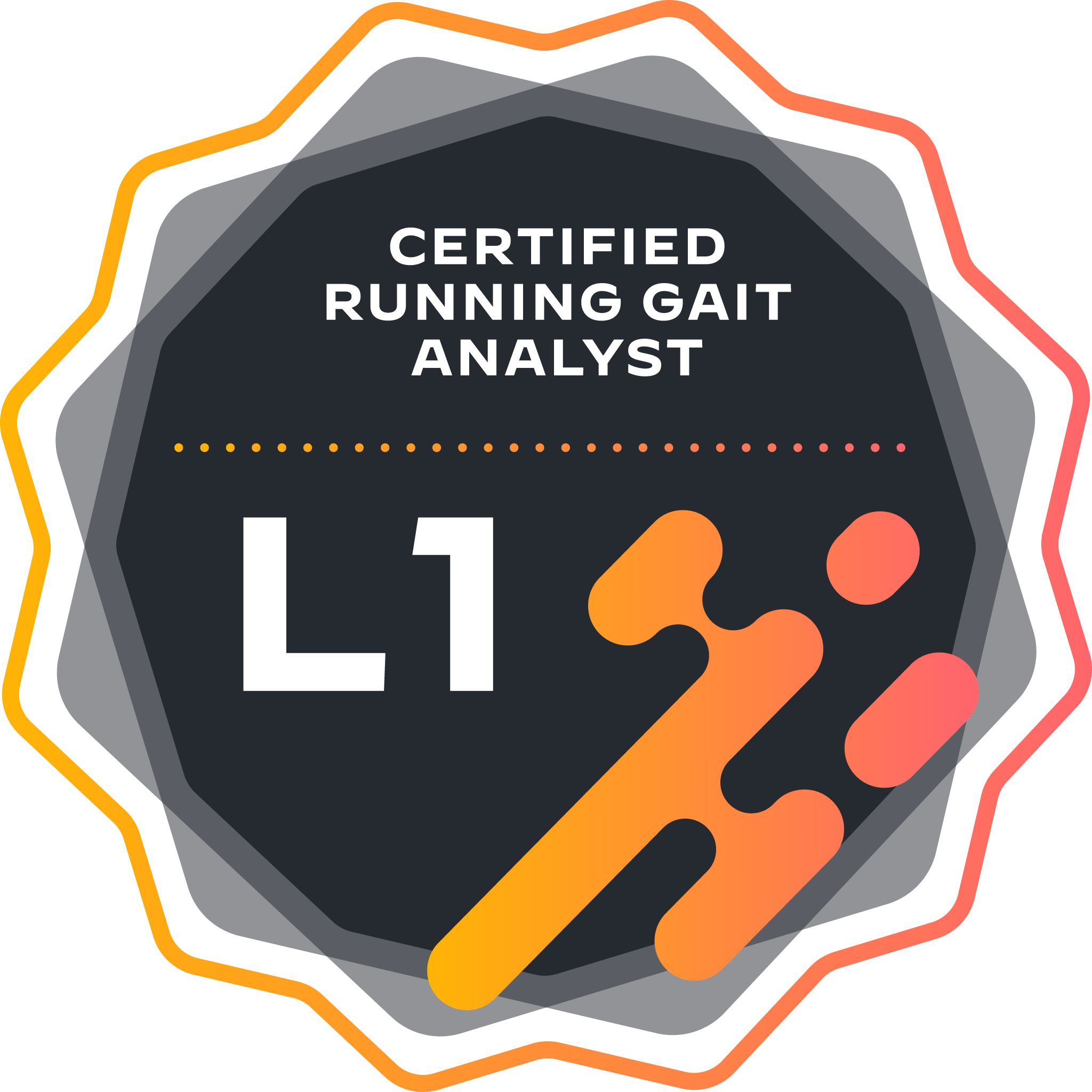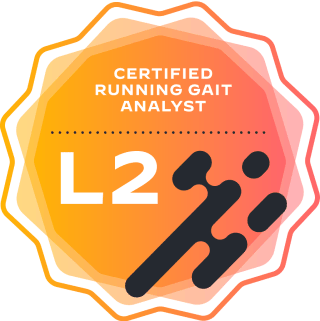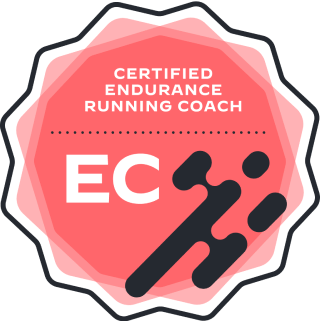Level 1 Certified Running Gait Analyst
A must-do running CEU course for anyone looking to provide runners the highest level of service.
Be confident in analyzing gait and providing programs to improve motor control, mobility, and technique specific to each runner, or athlete who runs, based on their movement patterns.
Learn a systematic approach to analyze running form and address the most common mobility and strength deficits found in runners.
In-Depth Biomechanics
Learn the 5 most common categories of running gait that lead to injury based on the latest evidence. Running can be complicated. We’ve simplified the complexities of running into these 5 categories to get excellent results with runners.
Runner Readiness Assessment
The Runner Readiness Assessment is a quick functional movement screen to identify mobility and motor control deficits critical to running form. With the RRA, you can identify the top priorities and know where to start to make the biggest gains.
2D & 3D Analysis
Whether you use 2D or 3D, Level 1 shows you evidence based ways to analyze gait and identify form deviations leading to injury. With our gait retraining cues for each category, you’ll be able to use 2D and 3D to show your runners they’re improving.
Comprehensive Plans
We’ve built the resources so that you can focus on the runner instead of the paperwork. Each running category and section of RRA has a tailored plan to individualize what your runner needs.
Case Studies
Learn from real life examples and hear how the instructors handle these tricky cases! Practice on your own and see how your plans match up.
RunDNA Portal
Receive a free trial to the RunDNA Portal to organize your runners data and track their progress.
Course Preview

Runners Are Looking For You
WHY GET CERTIFIED?
RunDNA education is all about making you the top running expert. We have taken years of research and experience to design a movement based systematic approach to treating and training runners. With a Level 1 Certified Running Certification, you’ll join the community of top running specialists! (Curious about Level 2?)
Become a Running Expert


L1 + L2 Running Gait Analyst Certification Bundle
Get all of the knowledge, skills, and tools you need to specialize in running. Learn to analyze and correct gait while building a business focused on runners.
- Level 1 Certified Running Gait Analyst
- 12 hours total continuing education
- Level 2 Certified Running Gait Analyst
- Over 40 handouts included to get started right away



The Gait Analysis bundle
Get all three Gait Analysis courses and become the expert in all things gait!
- Level 1 Certified Walking Gait Analyst
- Level 1 & 2 Certified Running Gait Analyst
- 18 hours total continuing education
- Over 60 handouts included to get started right away

Level 1 Running Gait Analyst Certification
Be confident in analyzing gait and providing programs to improve motor control, mobility, and technique specific to each runner, or athlete who runs, based on their movement patterns.
- Runner Readiness Assessment
- 5 Categories of Running Gait Impairments
- Detailed corrective programs
- 5 CEU Hours

Level 2 Running Gait Analyst Certification
Become an expert in treating and training runners. Learn to address complex cases, work with specific injury types, add jumping assessments, and provide detailed strength programs.
- 12 Categories of Running Gait Impairments
- Loading Levels
- Detailed strength, jumping, and injury specific plans
- 7 CEU Hours

Level 1 Endurance Running Coach Certification
Complete your training with a systematic approach to personalize each training plan. Central to the course is a scientifically backed method which quantifies fitness levels and training loads.
- Three key components of endurance running performance
- Scientific Approach to training load
- Race specific training plans
- 7.5 CEU Hours
MEET YOUR INDUSTRY LEADING INSTRUCTORS

Doug Adams
Dr. Doug Adams is a Physical Therapist who has published and spoken at an international level on all things related to running. Doug has taught thousands of professionals his systematic approach to providing personalized plans for runners through the Certified Running Gait Analyst and Endurance Running Coaching courses. He also designed and created a portable 3D Motion Analysis system called Helix 3D for analyzing and categorizing running form that is used widely throughout the Department of Defense and commercial sectors.
- Team PT for Tinman Elite Professional Running Team
- Adjunct faculty for the 711th Human Performance Wing of the US Air Force
- Co-Founder Omega Project PT in Wilmington, Delaware that specializes in treating endurance athletes and runners

Scott Greenberg
Scott is a sport medicine expert with an emphasis on optimizing running performance, running injury prevention, treating running-related injuries, and foot orthoses.
As the Manager of Clinical Operations for UF (University of Florida) Health’s Outpatient Rehabilitation department, Scott has dedicated his career to working with University of Florida Athletes to optimize their running, speed, and agility performance. He is the Running Injury and Biomechanics Consultant to University of Florida Track and Cross Country and Foot and Ankle Specialist for University of Florida Athletic Association Athletes. He is also a Certified Endurance Running Specialist, a USA Track and Field Certified Level 1 Coach, and Certified Strength and Conditioning Specialist. Scott is a nationally recognized lecturer in the area of running medicine and is the current Chairman of the Academy of Sports Physical Therapy’s Running Special Interest Group.
He currently resides in Gainesville, Florida with his wife and two daughters.
Frequently Asked Questions
Who are these courses for?
Whether you work with runners all day long or a few times a month, this course will give you the confidence and clarity to achieve excellent results and accelerate your success. Physical therapist, Chiropractors, Athletic Trainers, Physicians, Podiatrists, Personal Trainers, Running Coaches, and Running Retail Specialists will find immediate and applicable knowledge, no matter what level of experience . There are NO requirements to have special technology or applications to obtain the benefits of this course.
How long do I have access to the course for?
Once you register, you’ll have access to the course indefinitely. This course is available on our website, so you can watch it anywhere and at your own pace.
How difficult is the course?
The instructors provide all of the background and information needed so that you can apply everything. If you do not have a background in anatomy and biomechanics you may want to take our free Essential Elements course prior to Level 1.
What are the Learning objectives of the course?
Course Learning Objectives:
- By the end of the course, the participant will be able to infer 3 reasons why runners develop Running Related Musculoskeletal Injuries
- By the end of the course, the participant will be able to interpret Running Readiness Assessment results and prescribe exercises based off of individualized results
- By the end of the course, the participant will be able to interpret Running Readiness Assessment Foot screen results and prescribe exercises based off of individualized results
- By the end of the course, the participant will be able to interpret Running Readiness Assessment motor control screen results and prescribe exercises based off of individualized results
- By the end of the course, the participant will develop a plan of care utilizing presented motor learning principles and tools to gait re-train a patient for each of the 5 classifications of running gait deviations discussed in this course
- By the end of the course, the participant will be able to infer 2 of the most common mobility restrictions contributing to collapsing running gait deviation
- By the end of the course, the participant will be able to infer 3 of the most common motor control impairments contributing to collapsing running gait deviation
- By the end of the course, the participant will be able to infer the most common mobility restriction contributing to over striding running gait deviation
- By the end of the course, the participant will be able to infer 2 of the most common motor control impairments contributing to collapsing running gait deviation
- By the end of the course, the participant will be able to infer the most common mobility restriction contributing to Bouncer running gait deviation
- By the end of the course, the participant will be able to infer 2 of the most common motor control impairments contributing to Bouncer running gait deviation
- By the end of the course, the participant will be able to infer 2 of the most common mobility restrictions contributing to weaver running gait deviation
- By the end of the course, the participant will be able to infer 3 of the most common motor control impairments contributing to weaver running gait deviation
- By the end of the course, the participant will be able to infer 2 of the most common mobility restrictions contributing to collapsing running gait deviation
- By the end of the course, the participant will be able to infer 3 of the most common motor control impairments contributing to collapsing running gait deviation
- By the end of the course, the participant will be able to infer 3 of the most common mobility restrictions contributing to Glute Amnesiac running gait deviation
- By the end of the course, the participant will be able to infer 4 of the most common motor control impairments contributing to Glute Amnesiac running gait deviation
- By the end of the course, the participant will develop a comprehensive gait re- training program for a runner in each of the 5 common running gait deviation categories based upon gait analysis data
What are Level 1 Certified Running Gait Analysts finding most beneficial about the certification?
“I really like the running readiness assessment and breakdowns for each of the screening tools. I also liked the interventions given based on specific mobility/stability impairments. Since the course is self-paced, I’ve already effectively used some of the strategies with my runners!” L. Wong, DPT
“From reviewing the case studies which bring together the whole systematic approach, I’ve been able to determine a better prescription for the runners I’m working with who are recovering from running injuries. Already, I am seeing more runners referred by current patients.” A. Xavier, DPT
Do I need your Helix 3D System to apply the principles of the course?
There are no requirements for any specific technology to apply the systematic approach of our course. We may use technology for teaching purposes, but we have thousands of people that have taken the course without using 3D.
Is this course approved for CEUs?
YES! This course is worth 5 CEU hours. We have approvals with the BOC, NSCA, PACE, and many state PT boards/associations. Please check your state to confirm approval. The majority of US states are approved via reciprocity rules. See the specific rules for your state below. States not approved will say “Not Pre-Approved.”
AL: AC 7 00-X-2-.08 (5)
AK: Section 12 AAC 54.420, 1d-e
AR: Pre-Approval Not Req.
AZ: Accepts APTA Approval (OH, TX)
CA: Board Approved Provider
CO: 4 CCR 7 32-1,L,3b1
CT: Section 20-7 3b
DE: Section 13.2.1
FL: Rule-Approved Provider
DC: Accepts APTA Approval (OH, TX)
GA: Rule 490-4-.02, 3, ab
HI: HRS section 461J-10.13
ID: IDAPA 24 – 24.13.01, 250.09
IL: Licensed CE Sponsor
IN: IC 25-1-4-0.2, Sec 5, a, 9
IA: IA Guideline for CE Sponsors
KS: K.A.R. 100-15-4
KY: 201 KAR 22:045, Sec.2, 2a
LA: Not Pre-Approved
MA: 259 CMR 7 .03(2b)
ME: Not Req.
MD: Accepts APTA Approval (OH, TX)
MI: R 338.7 163
MN: Board Approved # 11899
MS: Accepts APTA Approval (OH, TX)
MO: 20 CSR 2150-3.203, 5, A
MT: 24.17 7 .2105, 9, ii.
NC: 21 NCAC 48G .0108,c6
NE: 17 2 NAC 137 , 002.05
NH: Phy 406.03
ND: R&R, article 61.5-03-02-02. 1
NM: Accepts APTA Approval (OH, TX)
NJ: Board Approv ed # 2412-7 5
NV: Not Pre-Approved
NY: Not Pre-Approved
OK: Not Pre-Approved
OH: APTA Approved # 25S0481
OR: 848-035-0030, Sec 2ab
PA: § 40.67 , d
RI: 13.4.5, d, 3
SC: 101–07 , 3b
SD: Article 20:66:03:02
TN: Not Pre-Approved
TX: APTA Approved # 80091TX
UT: R156-24b-303b 2, c
VT: Rule 4.4. c, 3, 4
VA: 18VAC112-20-131, B, 1
WA: WAC 246-915-085
WI: Section PT 9.04, b
WV: Not Pre-Approved
WY: Ch 6, Section 2a
BOC:
The course is approved for 5 Category A CEUs through the BOC.
NSCA:
This program is eligible for Category A CE. NSCA – The National Strength and Conditioning Association approved 0.6 CEU(s) in category C for certified indiv iduals who successfully complete this course. [L1 647 -HSCRG1].
PACE:
RunDNA is recognized by the PACE program of the Federation of Chiropractic Licensing Boards.
Are there requirements to maintain the Level 1 Certification?
While we encourage you to continue learning (and will provide opportunities for you to do so) there is no requirement for maintaining Level 1 certification.
is there a refund policy?
RunDNA offers a 30-day money-back guarantee for all online education courses. If a participant is not satisfied with their purchase for any reason, they may request a full refund within 30 days of the original purchase date.